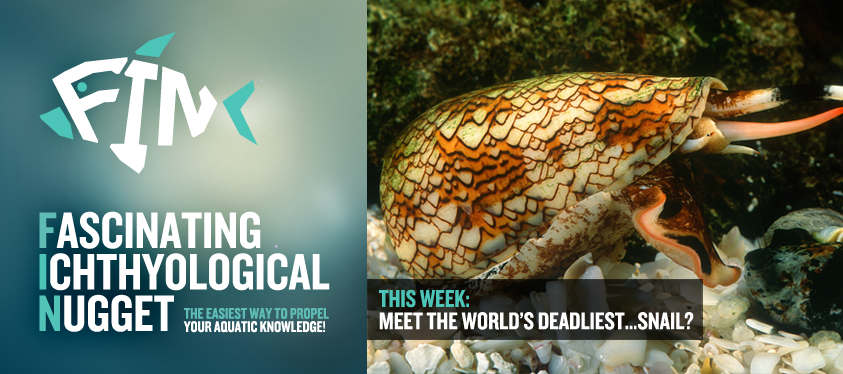Cookie Policy
We use cookies to help improve the experience you have on this site. You can find out more here.
We use cookies to help improve the experience you have on this site. You can find out more here.


When you think of some of the deadliest creatures in the seas, you naturally think of great white sharks, killer whales or giant squid. Snails probably don’t come to mind very readily, but then the Cone Snail (Conus geographus) isn’t your average escargot…
Making its home in the warm waters of the tropics and around coral reefs, C. geographus may seem to be as slow and innocuous any of its land-based cousins, but it is actually one of the most deadly and venomous invertebrates on earth. The secret lies in the hollow little “harpoons” that they manufacture and store within a sac in their bodies. When on the hunt and faced with its favourite prey such as molluscs, worms or fish, the snail “ arms” the hollow harpoon with a venomous cocktail containing up to 200 different toxins. It then loads the harpoon into a specialised proboscis and then fires the deadly missile into its hapless victim. The venom then acts a neurotoxin, disabling the prey’s nervous system and paralysing it, thus making it an easy task for the snail to engulf it and devour it at leisure.
The nerve-blocking toxins are so effective that they’ve sparked the interest of biomedical researchers, who have studied them and developed them into a painkiller for cancer sufferers that acts in a similar way to morphine. The toxins have even become the focus for research into treatments for other neurological conditions such as Alzheimer’s, Parkinson’s and epilepsy.
But despite the useful medical applications of its venom, the Cone Snail itself remains a creature that you certainly wouldn’t want to run afoul of in the wild. C. geographus is known to have caused at least 30 human deaths, and any person unlucky to be stung only has about a 30% chance of surviving the encounter.
They might not be as generous as the easter bunny, but rabbitfish are very giving when it comes to algae control. This One-spot fox face (Siganus unimaculatus) at Reefkeeper Rugby makes a great alternative to the more active tangs but will reach a size that necessitates a spacious aquarium. Every time I write about these fishes I wonder why the old common name of Badger fish isn’t more widely used, but then the native name of Spinefoot (thanks to their stinging venomous dorsal spines) is perhaps more deserved in areas where they’re caught as food fish.
https://www.fishkeeper.co.uk/fish/marine/miscellaneous-fish/one-spot-fox-face-
For delivery before Christmas, orders must be placed on or before 3pm on Wednesday 20th December. We cannot guarantee delivery of these orders pre-Christmas as we are reliant on our couriers, but will use our best endeavours to get orders placed on this date out to you before Christmas. For full details of our festive delivery and opening times click here
Please note: online orders placed after 3pm on Friday 22nd December will not be dispatched until the New Year. For full details of our festive delivery and opening times click here